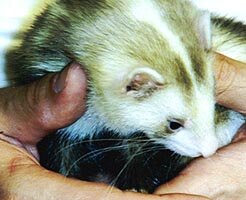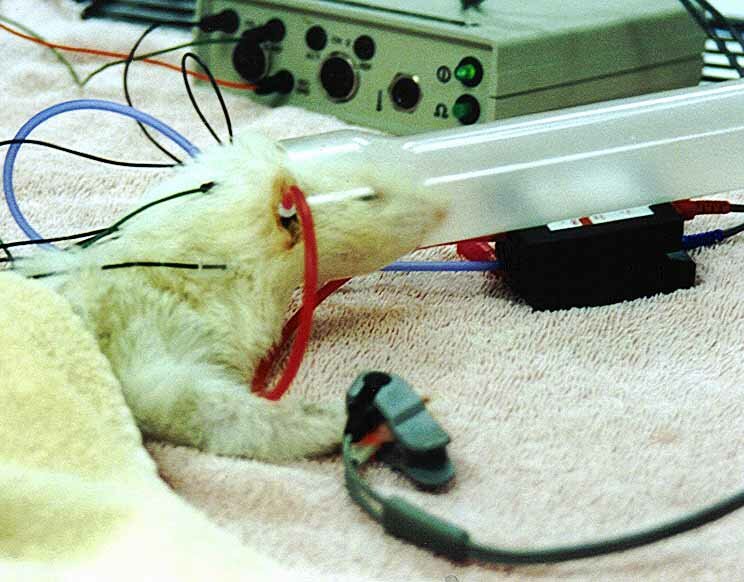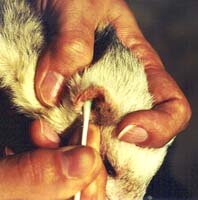|
||
|
|
Ferrets have a highly developed sense of hearing. Learn how to take care of your pet's ears. |
|
Disclaimer:
|
Sometimes we take our ferrets’ ears for granted, preferring to gaze into their adorable eyes. Ferret can move their ears, but not as well as other animals, so their ears may not seem expressive of emotion. However, the ferret has a highly-developed sense of hearing, and ears need to receive proper care to maintain this important sense. Deaf ferrets also need ear care, and special understanding of their lack of hearing.
PARTS OF THE EAR A ferret’s ear is made up of three parts: the outer ear, the middle ear, and the inner ear. The outer ear is the part you can see, including the auricular appendage or pinna (the external flap of skin, fur, and cartilage outside the skull), and the ear canal. Most ear problems in ferrets occur in this zone, including infections, parasites, and occasionally tumors. The middle ear begins with the ear drum, and includes the eustachian tubes, which connect to the nasal system. The middle ear also contains small bones that transmit sound vibrations to the inner ear. Infection of the middle ear can come through the eustachian tubes (if the ferret has a cold, for example). Inflammation and infections also happen if the eardrum is ruptured, either by parasites or something poking down the ear canal. These infections are more difficult to treat. The inner ear is the area that "understands" sound waves and transmits them to the brain. Infections in this area can cause equilibrium problems, which may cause your ferret to act dizzy or off-balance. Degenerative changes in this area cause deafness. FERRET HEARING Baby ferrets cannot hear until they are 30-32 days old when the ear canals open. Then the ferret auditory system evolves and reaches adult hearing levels at about 6 weeks. Ferrets are unusually adept at discerning the direction and location of a sound source, because the hearing receptors in their ears can "map" auditory space better than other animals. Normal ferret hearing is within a range pitched higher than the range of sounds heard by humans (except for lactating jills, whose hearing range temporarily increases to the higher levels expressed by kits). How a ferret’s hearing may change as a result of aging has not been well documented, but older ferrets may rely more on what they hear as their eyesight ability diminishes. Normally, the lower limit of a ferret’s hearing is about 36 Hz, which is about the same as that of a cat, but higher than the lower limit of human hearing at 20 Hz. The upper level of a ferret’s hearing range is about the same as the upper level of a dog and the lower level of a bat at about 44 kHz, while the upper level of human hearing is only 17 kHz. This explains why ferrets react strongly to the sound of squeaky toys; these sound are in the range that a ferret can hear best (8-12 kHz). Ferret owners often train their ferrets to "come" to the sound of a squeaky toy with greater success than other sounds. It is possible that ferrets may react less to the deeper voices of human males. FERRET LISTENING Although ferret hearing ranges have been demonstrated scientifically, just because ferrets can hear does not necessarily mean they will pay attention and listen. Ferrets are curious critters who react to and investigate the most interesting thing in their environment, which may be a potted plant to dig up rather than the sound of your voice shouting "no!" A ferret may seem to come when you call his name, but that may be because you are more interesting than whatever he was doing at the time you called. At other times, no amount of sound can dissuade a ferret from an interesting task at hand, such as hiding your socks. Additionally, when ferrets are in deep sleep, sounds may not rouse them. So although ferrets may have excellent hearing, they may be annoyingly deficient in listening. Just because your ferret pays no attention to your noises does not mean she is deaf. DEAFNESS IN FERRETS Unfortunately, deafness in ferrets is common. Albino ferrets, although able to hear, have abnormally small hearing mechanisms in their middle and inner ear. "Blaze" and "Panda" ferrets often suffer from the genetic defect called Waardenburg’s Syndrome. This defect causes the white "badger stripe" or forelock down the face of ferrets. Mutations of this stripe show up in panda ferrets with white faces and heads. Waardenburg’s Syndrome can also result in blue-eyed ferrets, and can be present in dark-eyed whites. This genetic defect does not allow the hearing mechanism of the inner ear to develop, and it is estimated that 75% of badger and panda ferrets are deaf. Unfortunately, the attractive color patterns of dark-eyed whites, badgers, and pandas are highly sought after, and breeders do not always test for deafness, because this can be difficult. Determining if a ferret is deaf takes skill and observation on the part of the owner, especially because hearing ferrets are sometimes unresponsive to sounds. However, deaf ferrets may have several characteristics that may help diagnose their problem. Deaf ferrets are easily startled if approached from behind. Additionally, deaf ferrets are often more vocal than hearing ferrets and express surprise when they are startled with a scream. Ferrets are sensitive to movement and vibration, so if you clap or stamp your foot on the floor to determine deafness, your ferret may be reacting to the movement of your body or the vibration in the air or on the floor rather than the sound. A better at-home test is to place a vacuum cleaner in the room with your ferrets, but stand where the ferrets cannot see you, and then plug in the vacuum cleaner to turn it on. In most cases, the hearing ferrets will scatter (or attack the vacuum), and the deaf ferret will wonder why everyone else left! The hearing test known as the brainstem auditory evoked response (BAER) or brainstem auditory evoked potential (BAEP) is potentially useful in determining deafness in ferrets. This is a test performed routinely by reputable Dalmation breeders to determine the extent of hearing loss or deafness in their breeding stock. The test detects electrical activity in the inner ear and brain in much the same way that an antenna detects radio signals or an EKG detects the heart’s electrical activity. Electrodes are placed around the ear and on the head, and send pictures of "hearing" to a computer. The response waveform consists of a series of peaks from the inner ear and the brain. The response from a deaf ear is a flat line. This procedure is not painful and no sedation is necessary. Deaf ferrets pose potential behavioral and training problems. Deaf mother ferrets may be more likely to eat their young because they cannot hear their cries. Deaf ferrets also seem to be more prone to bite, as deaf ferrets are easily startled and immediately try to defend themselves. Additionally, deaf ferrets are more difficult to train, because they do not respond to your voice commands or other sounds. Deaf ferrets do respond to lots of love, treats, and can even be trained to hand signals. However, because of the difficulties posed by deaf ferrets, particularly for beginner owners, it is hoped that ferret breeders are more careful about breeding for color patterns without the associated hearing problems. EAR WAX Ferret ears produce ear wax, which is normally light brown, orange, or reddish in color. Different ferrets will have different amounts and colors of ear wax, so it is difficult to define what is "normal." Also, the same ferret can produce varying amounts of ear wax at different times of the year. If wax is not cleaned out regularly, a strong odor will build up, and your ferret may experience hearing loss and discomfort from pressure and infections. Additionally, the wax becomes a breeding ground for ear mites. EAR MITES Ear mites are the ferret "social disease." Ear mites are very common in ferrets and highly contagious. Most kits carry ear mites home from the petstore or breeder. The mites can also be transmitted to and from cats and dogs. This means that if you have more than one ferret, or have other pets, all the ferrets and pets should be treated. You should suspect ear mites in any ferret who has ear wax that is dark brown, reddish black, or black. The wax also has a strong, distinct odor, and there is often more wax than normal. Ferrets with ear mites may also shake their heads, rub their ears along the floor, scratch at their ears, or walk with the head tilted to one side. Your veterinarian can look at your ferret’s ear wax under a microscope to determine if mites are present. Sometimes adult mites can be seen under a magnifying glass, but mite eggs and larva are too small to be seen, so a veterinarian’s microscope examination is the most definitive way to diagnose an ear mite problem. Ear mites can be much more serious than mere irritation. Extreme infestations of mites can burst the eardrum, and the presence of ear mites can lead to serious ear infections in the middle or inner ear. An overpopulation of mites in the ear can cause the mites to migrate out onto the head and body, where they will burrow into the skin, causing further irritation and infection. Because ear mites have a life cycle (eggs, larva, nymph, and adult), treatment must span two to three weeks to kill mites in all stages and stop the cycle. For an at-home treatment, start by washing all bedding, and bathing the ferret in a mild flea shampoo to kill surface mites. Then use a miticide medication that is labeled as safe for kittens or rabbits (usually 0.05% Pyrethins). The miticide liquid must be squirted into the ear canal and rubbed in thoroughly each day for a minimum of 14 days (21 is better). Ferrets generally don’t appreciate this treatment, and struggle vigorously while shaking their head, spraying medication everywhere. Alternatively, your veterinarian can apply a once-a-week treatment of ivermectin for two to three weeks. Your vet can determine after the second treatment whether any more eggs are apparent and further treatments are needed. Do not use ivermectin treatments on breeding, pregnant, or lactating jills, as birth defects may result. If you have many pets in your household, the ivermectin may not be as cost-efficient as at-home treatment because all pets must be treated at the same time, or reinfestation will occur. The best way to prevent reinfestation is to keep the ears clean, although clean ears are not a guarantee against earmites. CLEANING THE EAR It is essential that you clean your ferret’s ears often–every other week is a good regimen. Regular ear cleaning will minimize ear wax odors and help prevent ear mite infestations. However, most ferrets object to having their ears cleaned, so the first few cleanings may be a real challenge! You may need assistance from another person to help keep your ferret still. With practice, one person can scruff the ferret with one hand and clean the ear with the other. Another method of restraint while cleaning is the "triangular head hold." Distractions with treats such as Linatone (TM) and Ferretone (TM) are also useful. Ear cleaning during or after bath time is also recommended, particularly to make sure that extra soap and water residue is removed from your ferret’s ears. Use cotton swabs to clean your ferret’s ears. Do not use a dry swab, which can irritate the sensitive skin inside the ear. Moisture is needed to clean the ear. Use an ear-cleaning solution (such as OtiClens (TM)) or a miticide (such as Nolvamite (TM)) that is labeled as safe for use in kittens or rabbits (preparations labeled for cats and dogs but not kittens may be too harsh). Do not use preparations intended to dry out the ear, and do not use rubbing alcohol, which can destroy sensitive ear tissue. Mineral oil, which is a common home remedy for other pets, seems only to add to the oily buildup in the ear and is not recommended. Hydrogen peroxide can be used occasionally, but also tends to dry the ear out. Moisten the cotton swab with the ear-cleaning solution and gently wipe it through the crevices of the outer ear. Ferret ears have many folds and pockets in their outer ear, and it may take several swabs to remove all the debris collected in these crevices. Only clean the part of the ear you can see! Do not push the cotton swab into the ear canal, even if you see wax in the canal. If your cotton swab got too wet with cleaning solution and left fluid in the ear, gently dab off the excess with a dry cotton swab. OTHER EAR MEDICAL PROBLEMS Yeast infections and other ear infections can occur in ferrets. Swollen ears, an abnormal fluid discharge, or granular debris may be signs of other types of infections. Often, these infections occur along with ear mite infestations, but not always. Your veterinarian can stain a sample of ear debris and look under the microscope to determine if a yeast or other types of infection are present. Medication could include topical creams (such as CGB), or antibiotics taken orally. Ferrets with swollen ears (as well as nose or face) who do not respond to medication may be suffering from food allergies. Switching to a non-poultry-based food might help in these circumstances. EAR TATTOOS "What are those markings on my ferret’s ear?" is a common question for new owners. Many (but not all) ferret breeders place a tattoo on one ear of their ferrets. Tattoos come in many colors (blue, purple, green, red, and orange) and patterns (letters, symbols, or dots). The most common tattoo is the Marshall Farms marking of two blue dots in the right ear. I know of one new owner who rushed his ferret to the nearest emergency vet because of the blue ear spots. The vet, not experienced with ferrets, incorrectly diagnosed the dots as an ear mite infestation, and prescribed strong medications to clear up the "bruising and infection." Not to worry, these tattoos are not painful to the ferrets and are not likely to cause problems. EAR LICKING/GROOMING You will often see ferrets licking or grooming other ferrets’ ears, or even human ears. Ear licking is a behavior that can either be used to assert dominance or discipline, or is used to placate a more assertive ferret. Mother ferrets groom their babies’ ears to discipline them. Sometimes an older ferret will become tired of a younger ferret’s play antics, and the older ferret may pin down the younger ferret and forcibly wash its ears in an effort to say "leave me alone!" Often, the ferret being groomed will scream, cry, and struggle during this procedure. On the other hand, a submissive ferret may also groom a dominant ferret’s ears in an effort to pacify the dominant ferret. In this case, ear grooming often takes place while one ferret is asleep. EAR INJURIES During rough play, ferrets (especially kits) may use their teeth to grab an opponent by the ear and drag the loser around. The losing ferret is usually quite vocal. If the bite is severe and the ear is bleeding or punctured, treat with an antibiotic ointment such as Neosporin (TM). These wounds usually heal quickly. Discipline the biting ferret with a "timeout." Deaf ferrets often do not know when to let go because they cannot hear their playmate crying. Ears can also become injured by altercations with other pets (such as cats with claws), or by foreign objects (such as a sharp edge on exposed cage wire). Severe injuries may require stitches or surgical "glue" and often result in "cauliflower" ears, as the cartilage may not be able to heal properly. A FINAL NOTE ON EARS Ferrets have a highly-developed sense of hearing, and rely on their ears to understand the world around them. Their ears are sensitive, however, and should be well cared for. Hearing loss can result from sounds that are too loud, so keep the stereo and television volume at a reasonable level. Avoid lots of high-pitched sounds or dog whistles, which may aggravate your ferret. And finally, keep those ears clean!
|
|






